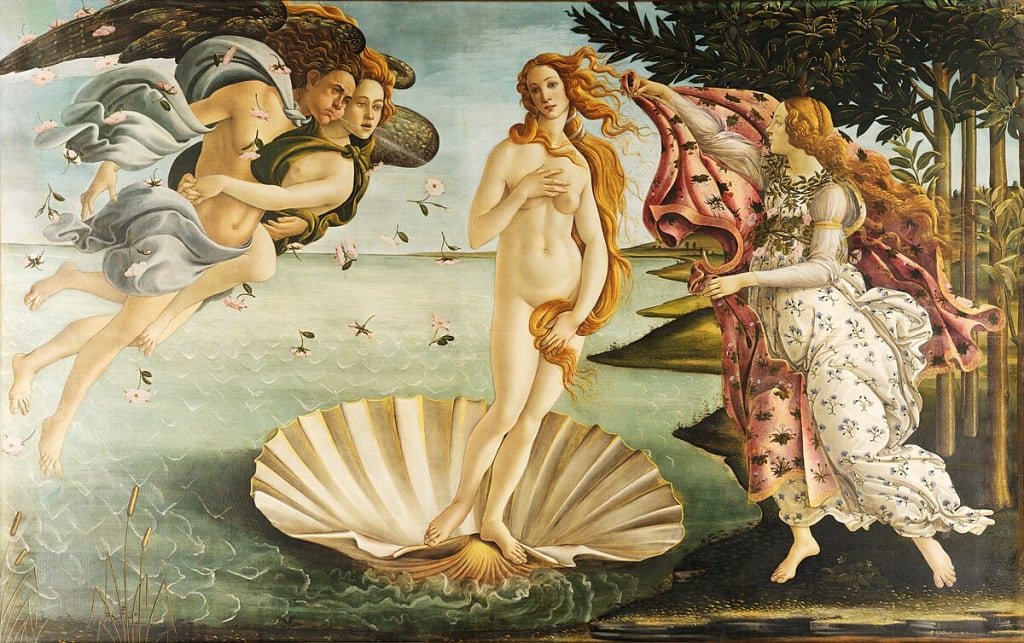The Awakening of Venus
Sublime Emergence: The Birth of Venus (A work of art by Sandro Botticelli)

In the ancient realm of gods and goddesses, a celestial artist named Pallas labored tirelessly to create a masterpiece that would capture the essence of beauty itself. Pallas was renowned for his ability to breathe life into his creations, infusing them with a divine spark that made them come alive. His latest endeavor was inspired by the mysterious allure of the sea, and he envisioned a figure that embodied both purity and passion—a goddess born from the depths of the ocean.
Days turned into weeks, and weeks into months as Pallas meticulously shaped and molded his creation. Every curve and contour of her form was carefully crafted, ensuring that the figure possessed a captivating grace that would enchant all who beheld her. Finally, after what seemed like an eternity of ceaseless toil, Pallas stood back, his heart pounding with anticipation. The time had come for his masterpiece to be brought to life.
With a flourish of his hands, Pallas called upon the divine energies that coursed through his veins. The very essence of creation responded to his command, and a brilliant light engulfed the sculpture. As the radiance faded, Pallas found himself staring into the most enchanting pair of eyes he had ever seen. His creation had come alive, and she was more magnificent than he had ever imagined.
The newly awakened goddess gazed around in wonder, taking in her surroundings. She found herself standing upon a seashell, gently gliding through the azure waters of the Mediterranean. The sunlight danced upon her porcelain skin, illuminating her every contour. Her long, flowing hair cascaded down her back like golden waves, and a serene smile played upon her lips. Pallas had succeeded in bringing forth a goddess—a being of ethereal beauty named Venus.
As Venus took her first steps upon the soft sands of the shore, she felt a sense of freedom and exhilaration. The world unfolded before her in all its splendor, and she reveled in its breathtaking sights and sounds. The vibrant hues of the flowers, the gentle caress of the wind, and the chorus of birdsong filled her senses with pure delight. Venus was the embodiment of love and beauty, and wherever she went, she inspired awe and adoration.
News of the goddess quickly spread throughout the land, drawing people from far and wide to catch a glimpse of the divine being. Artists, poets, and scholars flocked to Venus, eager to capture her essence and bask in her presence. They marveled at her grace, her elegance, and the ethereal aura that surrounded her. Her radiance enchanted all who beheld her, leaving them forever changed.
But Venus was not content with merely being an object of admiration. She longed to experience the world and all its wonders firsthand. With an insatiable curiosity, she embarked on a journey, guided by the gentle whispers of the wind. She wandered through ancient cities, explored verdant landscapes, and danced beneath the stars. Everywhere she went, Venus left a trail of beauty and inspiration in her wake.
However, not everyone welcomed Venus with open arms. Some feared her influence, believing that such power and allure could only lead to chaos and destruction. They sought to imprison her, to stifle her divine light. But Venus was not so easily contained. With each attempt to subdue her, she only grew stronger, more resilient.
One fateful day, as Venus stood on a cliff overlooking the vast expanse of the sea, she heard a familiar voice—a voice that called to her from the depths of the ocean. It was the voice of her creator, Pallas, beckoning her to return to him. Venus knew that her time on Earth had come to an end, and she felt a pang of sorrow at
the thought of leaving behind the world that had embraced her so fully.
With a heavy heart, Venus dived into the crystal-clear waters, allowing the currents to carry her back to Pallas. As she emerged from the sea, Pallas greeted her with a mixture of pride and sadness. He had achieved his vision of creating the most beautiful being in existence, but he knew that Venus belonged to the world, not to him alone.
With a gentle touch, Pallas released Venus back into the realm of mortals. She would forever be remembered as the goddess of love and beauty, her presence immortalized in art, literature, and the hearts of those who had been touched by her radiance. And though Venus returned to her celestial origins, she left behind a legacy—a reminder that true beauty resides not only in physical form but also in the transformative power of love and the indomitable spirit of the human soul.
In the centuries that followed, artists would continue to be inspired by Pallas's masterpiece, "The Birth of Venus." The painting captured the essence of a moment frozen in time—a moment that forever captured the awakening of a goddess, the embodiment of beauty itself. And in the brushstrokes and colors of that masterpiece, the spirit of Venus lived on, continuing to inspire generations to come with her eternal allure.
About the Creator
Enjoyed the story? Support the Creator.
Subscribe for free to receive all their stories in your feed. You could also pledge your support or give them a one-off tip, letting them know you appreciate their work.





Comments
There are no comments for this story
Be the first to respond and start the conversation.